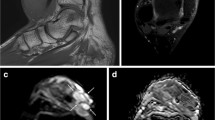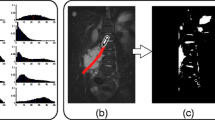Abstract
Purpose
To demonstrate the clinical use of FDG-PET/MRI for monitoring enlargement and metabolism of plexiform neurofibromas (PNF) in patients with neurofibromatosis type 1 (NF1), in whom the development of a malignant peripheral nerve sheath tumor (MPNST) is often a life limiting event.
Methods
NF1 patients who underwent a simultaneous FDG-PET/MRI examination in our institution from September 2012 to February 2018 were included. Indication was suspicion of malignant transformation of a PNF to MPNST. A maximum of six peripheral nerve lesions per patient were defined as targets. Standardized uptake values (SUV) and apparent diffusion coefficients (ADC) were measured. The presence of target sign and contrast-medium enhancement was visually recorded. Growth rates were estimated comparing prior or follow-up examinations and correlated with FDG uptake and ADC values. The presence of CNS lesions in cerebral T2 weighted images was recorded.
Results
In 28 NF1 patients a total number of 83 peripheral nerve tumors, 75 benign PNFs and eight MPNSTs, were selected as target lesions. The SUVs of MPNSTs were significantly higher than the SUVs of PNF (3.84 ± 3.98 [SUVmean MPNSTs] vs. 1.85 ± 1.03 [SUVmean PNF], P < .01). Similarly, lesion SUVmean-to-liver SUVmean ratios significantly differed between MPNSTs and PNF (3.20 ± 2.70 [MPNSTs] vs. 1.23 ± 0.61 [PNF]; P < .01). For differentiation between still benign PNF and MPNSTs, we defined SUVmax ≥ 2.78 as a significant cut-off value. Growth rate of PNF correlated significantly positively with SUVmean (rs = .41; P = .003). MRI parameters like ADCmean (1.87 ± 0.24 × 10−3 mm2/s [PNF] vs. 1.76 ± 0.11 × 10−3 mm2/s [MPNSTs]; P > .05], contrast medium enhancement (P = .50) and target sign (P = .86) did not differ between groups.
Conclusion
Simultaneous FDG-PET/MRI is a comprehensive imaging modality for monitoring PNF in NF1 patients. The combined acquisition of both morphologic information in MRI and metabolic information in PET enables the correlation of lesion growth rates with metabolic activity and to define SUV thresholds of significance to identify malignant transformation, which is of utmost clinical significance.








Similar content being viewed by others
References
Yap YS, et al. The NF1 gene revisited - from bench to bedside. Oncotarget. 2014;5(15):5873–92.
Ferner RE, et al. Guidelines for the diagnosis and management of individuals with neurofibromatosis 1. J Med Genet. 2007;44(2):81–8.
Ducatman BS, et al. Malignant peripheral nerve sheath tumors. A clinicopathologic study of 120 cases. Cancer. 1986;57(10):2006–21.
Evans DG, et al. Malignant peripheral nerve sheath tumours in neurofibromatosis 1. J Med Genet. 2002;39(5):311–4.
Combemale P, et al. Utility of 18F-FDG PET with a semi-quantitative index in the detection of sarcomatous transformation in patients with neurofibromatosis type 1. PLoS One. 2014;9(2):e85954.
Canavese F, Krajbich JI. Resection of plexiform neurofibromas in children with neurofibromatosis type 1. J Pediatr Orthop. 2011;31(3):303–11.
Wu JS, Hochman MG. Soft-tissue tumors and tumorlike lesions: a systematic imaging approach. Radiology. 2009;253(2):297–316.
Piscitelli O, et al. Neurofibromatosis type 1 and cerebellar T2-hyperintensities: the relationship to cognitive functioning. Dev Med Child Neurol. 2012;54(1):49–51.
Gayre GS, et al. Long-term visual outcome in patients with anterior visual pathway gliomas. J Neuroophthalmol. 2001;21(1):1–7.
Omuro A, DeAngelis LM. Glioblastoma and other malignant gliomas: a clinical review. JAMA. 2013;310(17):1842–50.
Broski SM, et al. Evaluation of 18F-FDG PET and MRI in differentiating benign and malignant peripheral nerve sheath tumors. Skelet Radiol. 2016;45(8):1097–105.
Demehri S, et al. Conventional and functional MR imaging of peripheral nerve sheath tumors: initial experience. AJNR Am J Neuroradiol. 2014;35(8):1615–20.
Gatidis S, et al. Comprehensive oncologic imaging in infants and preschool children with substantially reduced radiation exposure using combined simultaneous (1)(8)F-Fluorodeoxyglucose positron emission tomography/magnetic resonance imaging: a direct comparison to (1)(8)F-Fluorodeoxyglucose positron emission tomography/computed tomography. Investig Radiol. 2016;51(1):7–14.
Lu-Emerson C, Plotkin SR. The neurofibromatoses. Part 1: NF1. Rev Neurol Dis. 2009;6(2):E47–53.
Chawla SC, et al. Estimated cumulative radiation dose from PET/CT in children with malignancies: a 5-year retrospective review. Pediatr Radiol. 2010;40(5):681–6.
Boellaard R, et al. FDG PET/CT: EANM procedure guidelines for tumour imaging: version 2.0. Eur J Nucl Med Mol Imaging. 2015;42(2):328–54.
Schafer JF, et al. Simultaneous whole-body PET/MR imaging in comparison to PET/CT in pediatric oncology: initial results. Radiology. 2014;273(1):220–31.
Radiation dose to patients from radiopharmaceuticals (addendum 2 to ICRP publication 53). Ann ICRP. 1998;28(3):1–126. http://www.icrp.org/publication.asp?id=ICRP%20Publication%2080. Accessed 30 Nov 2018.
Vanderhoek M, Perlman SB, Jeraj R. Impact of the definition of peak standardized uptake value on quantification of treatment response. J Nucl Med. 2012;53(1):4–11.
Neubauer H, et al. Diagnostic value of diffusion-weighted MRI for tumor characterization, differentiation and monitoring in pediatric patients with neuroblastic tumors. Rofo. 2017;189(7):640–50.
Billiet T, et al. Characterizing the microstructural basis of "unidentified bright objects" in neurofibromatosis type 1: a combined in vivo multicomponent T2 relaxation and multi-shell diffusion MRI analysis. Neuroimage Clin. 2014;4:649–58.
Salamon J, et al. 18F-FDG PET/CT for detection of malignant peripheral nerve sheath tumours in neurofibromatosis type 1: tumour-to-liver ratio is superior to an SUVmax cut-off. Eur Radiol. 2014;24(2):405–12.
Derlin T, et al. Comparative effectiveness of 18F-FDG PET/CT versus whole-body MRI for detection of malignant peripheral nerve sheath tumors in neurofibromatosis type 1. Clin Nucl Med. 2013;38(1):e19–25.
Van Der Gucht A, et al. Metabolic tumour burden measured by 18F-FDG PET/CT predicts malignant transformation in patients with Neurofibromatosis Type-1. PLoS One. 2016;11(3):e0151809.
Warbey VS, et al. [18F]FDG PET/CT in the diagnosis of malignant peripheral nerve sheath tumours in neurofibromatosis type-1. Eur J Nucl Med Mol Imaging. 2009;36(5):751–7.
Bredella MA, et al. Value of PET in the assessment of patients with neurofibromatosis type 1. AJR Am J Roentgenol. 2007;189(4):928–35.
Ferner RE, et al. [18F]2-fluoro-2-deoxy-D-glucose positron emission tomography (FDG PET) as a diagnostic tool for neurofibromatosis 1 (NF1) associated malignant peripheral nerve sheath tumours (MPNSTs): a long-term clinical study. Ann Oncol. 2008;19(2):390–4.
Ferner RE, et al. Evaluation of (18)fluorodeoxyglucose positron emission tomography ((18)FDG PET) in the detection of malignant peripheral nerve sheath tumours arising from within plexiform neurofibromas in neurofibromatosis 1. J Neurol Neurosurg Psychiatry. 2000;68(3):353–7.
Chirindel A, et al. 18F-FDG PET/CT qualitative and quantitative evaluation in neurofibromatosis type 1 patients for detection of malignant transformation: comparison of early to delayed imaging with and without liver activity normalization. J Nucl Med. 2015;56(3):379–85.
Benz MR, et al. Utilization of positron emission tomography in the management of patients with sarcoma. Curr Opin Oncol. 2009;21(4):345–51.
Benz MR, et al. Quantitative F18-fluorodeoxyglucose positron emission tomography accurately characterizes peripheral nerve sheath tumors as malignant or benign. Cancer. 2010;116(2):451–8.
Kumar V, et al. Variance of SUVs for FDG-PET/CT is greater in clinical practice than under ideal study settings. Clin Nucl Med. 2013;38(3):175–82.
de Langen AJ, et al. Repeatability of 18F-FDG uptake measurements in tumors: a metaanalysis. J Nucl Med. 2012;53(5):701–8.
Laffon E, et al. Is liver SUV stable over time in (1)(8)F-FDG PET imaging? J Nucl Med Technol. 2011;39(4):258–63.
Combemale P, et al. Utility of 18F-FDG PET with a semi-quantitative index in the detection of sarcomatous transformation in patients with neurofibromatosis type 1. PLoS One. 2014. 9(2):e85954.
Nagata S, et al. Diffusion-weighted imaging of soft tissue tumors: usefulness of the apparent diffusion coefficient for differential diagnosis. Radiat Med. 2008;26(5):287–95.
Einarsdóttir H, et al. Diffusion-weighted MRI of soft tissue tumours. Eur Radiol. 2004;14(6):959–63.
Razek A, et al. Assessment of soft tissue tumours of the extremities with diffusion echoplanar MR imaging. Radiol Med. 2012;117(1):96–101.
Masayuki M, et al. Soft-tissue tumors evaluated by line-scan diffusion-weighted imaging: influence of myxoid matrix on the apparent diffusion coefficient. J Magn Reson Imaging. 2007;25(6):1199–204.
Petscavage-Thomas JM, et al. Soft-tissue myxomatous lesions: review of salient imaging features with pathologic comparison. Radiographics. 2014;34(4):964–80.
Rodriguez FJ, et al. Pathology of peripheral nerve sheath tumors: diagnostic overview and update on selected diagnostic problems. Acta Neuropathol. 2012;123(3):295–319.
Feany MB, Anthony DC, Fletcher CD. Nerve sheath tumours with hybrid features of neurofibroma and schwannoma: a conceptual challenge. Histopathology. 1998;32(5):405–10.
Matsumine A, et al. Differentiation between neurofibromas and malignant peripheral nerve sheath tumors in neurofibromatosis 1 evaluated by MRI. J Cancer Res Clin Oncol. 2009;135(7):891–900.
Bhargava R, et al. MR imaging differentiation of benign and malignant peripheral nerve sheath tumors: use of the target sign. Pediatr Radiol. 1997;27(2):124–9.
Suh JS, et al. Peripheral (extracranial) nerve tumors: correlation of MR imaging and histologic findings. Radiology. 1992;183(2):341–6.
Lin J, Martel W. Cross-sectional imaging of peripheral nerve sheath tumors: characteristic signs on CT, MR imaging, and sonography. AJR Am J Roentgenol. 2001;176(1):75–82.
Sevick RJ, et al. Evolution of white matter lesions in neurofibromatosis type 1: MR findings. AJR Am J Roentgenol. 1992;159(1):171–5.
Sekine T, et al. Reduction of (18)F-FDG dose in clinical PET/MR imaging by using silicon photomultiplier detectors. Radiology. 2018;286(1):249–59.
Taron J, et al. Simultaneous multislice diffusion-weighted imaging in whole-body positron emission tomography/magnetic resonance imaging for multiparametric examination in oncological patients. Eur Radiol. 2018;28(8):3372–83.
Kustner T, et al. Self-navigated 4D cartesian imaging of periodic motion in the body trunk using partial k-space compressed sensing. Magn Reson Med. 2017;78(2):632–44.
Watson KL, et al. Patterns of recurrence and survival in sporadic, neurofibromatosis type 1-associated, and radiation-associated malignant peripheral nerve sheath tumors. J Neurosurg. 2017;126(1):319–29.
Kar M, et al. Malignant peripheral nerve sheath tumors (MPNST)--clinicopathological study and treatment outcome of twenty-four cases. World J Surg Oncol. 2006;4:55.
Sekine T, et al. Evaluation of atlas-based attenuation correction for integrated PET/MR in human brain: application of a head atlas and comparison to true CT-based attenuation correction. J Nucl Med. 2016;57(2):215–20.
Author information
Authors and Affiliations
Corresponding author
Ethics declarations
Conflict of interest
Benjamin Bender received travel support by Bayer Vital and consultancy fees from Medtronic.
Ethical approval
All procedures performed in studies involving human participants were in accordance with the ethical standards of the institutional and/or national research committee and with the 1964 Helsinki Declaration and its later amendments or comparable ethical standards.
This retrospective study was approved by our local institutional ethical review board and informed consent was waived (Project Number: 345/2018BO).
Rights and permissions
About this article
Cite this article
Reinert, C.P., Schuhmann, M.U., Bender, B. et al. Comprehensive anatomical and functional imaging in patients with type I neurofibromatosis using simultaneous FDG-PET/MRI. Eur J Nucl Med Mol Imaging 46, 776–787 (2019). https://doi.org/10.1007/s00259-018-4227-5
Received:
Accepted:
Published:
Issue Date:
DOI: https://doi.org/10.1007/s00259-018-4227-5




